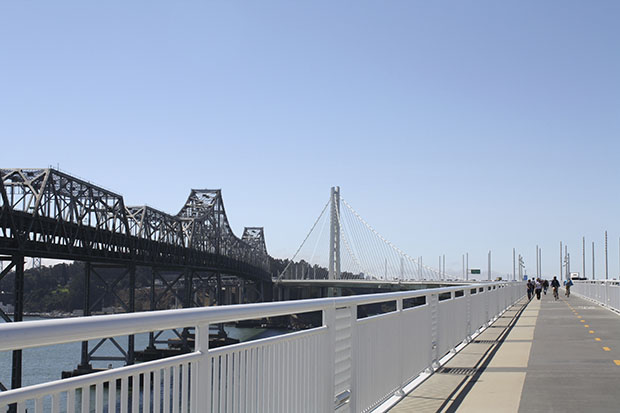With a dead end as its only destination and no access to San Francisco, the new Bay Bridge bike path could have been a tough sell.
But visitors to the eight-mile path, located alongside the eastern span of the Bay Bridge, seem to have found other reasons to enjoy its many possibilities, from biking, walking and scooting, to roller skating, protesting and just plain strolling.
Interviews on Sept. 14, the second Saturday that the bike path was open, found people with ample reasons to be there, from the serious to the frivolous.
A grizzled Fred Bialy, 61, of El Cerrito, arrived early to participate in the path’s first protest, sponsored by World Can’t Wait , a San Francisco peace advocacy group that was urging “U.S. hands off Syria.”
Wearing a shirt displaying the word “peace” in 16 different languages, Bialy pointed to a green “Fred” on his chest. “My name is the Swedish word for peace,” he said, proudly.
Along with Bialy were members of Code Pink, a San Francisco-based group known for its colorful activism.
World Can’t Wait protestors stretched their arms over the guardrails as megaphones blared.
“What has Obama done?” they cried. “All of this from a president we believed would stop war!”
Uniformed police followed the protestors to maintain public safety.
“The police are very supportive of First Amendment rights,” Bialy said.
“The police are just hanging around,” said bicyclist Beth Simone, 56, of San Pablo. “They aren’t disrupting anyone.”
In contrast, Miles Murphy, 18, and Sean Trimmer, 17, both of San Pablo, had a less political purpose for their visit: Exercise and a killer view.
“We’re going for a bike ride. I mean, it’s the Bay Area – (you) can’t really beat it,” Trimmer said.
But Murphy complained about the lack of facilities. “They should really have some water fountains,” he said.
Beautiful as it may be, the new bike path next to the beaming white span came at a high cost: $3.8 million of the $6.4 billion spent on the bridge went towards the bike path according to the San Francisco Chronicle’s website.
The cost will only soar higher with the planned additions to the path. While the current bike path is expected to connect to Yerba Buena Island in the summer of 2015, a planned extension that will connect it to San Francisco is expected to open in approximately 10 years, at a steep price of $550 million.
According to the Bay Bridge’s own website, the bridge opened in November 1936. The Loma Prieta earthquake struck in October 1989, and caused a partial collapse in the eastern span. The bridge was closed for temporary repairs, but it was clear that a long-term, seismically safe replacement would be necessary. Construction of the world’s longest self-anchored suspension span began in 2002, and opened to the public on Sept. 2.
The opening could not have come sooner for Urban students and faculty who live in the East Bay. Some 14 students and 11 teachers commute across the bridge every weekday. To them, the new span of the Bay Bridge is more than just a landmark.
“The path may be more of a tourist thing, but there’s nothing wrong with that. It allows people to explore the bridge,” said Adi Martin-Ruben (’16), of Oakland.
“It’s not utilitarian, but I will use it to walk after the old bridge is gone,” said history and English teacher Greg Monfils, 58, of Oakland. “It’s too ugly now.”
“Overall, I’m happy that when the big earthquake hits, this bridge shouldn’t fall over,” said Dylan Earp (’16), of Oakland.

